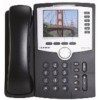Cisco SPA962-NA Administration Guide - Page 59
Using Call Features
 |
View all Cisco SPA962-NA manuals
Add to My Manuals
Save this manual to your list of manuals |
Page 59 highlights
Chapter 3 Managing Linksys 900 Series IP Phones Using Call Features • Remote Progressing: Another station is making a call on this call appearance and is progressing • Remote Active: Another station is engaged in a connected call on this call appearance • Remote Ringing: Another station is ringing for an incoming call to this call appearance • Remote Held: Another station has placed this call appearance on hold • Remote Undefined: The share call state is not known (this station is waiting for a notification from the application server) • Registration Failed: This station has failed to register with the proxy server for the corresponding extension • Registering: The station is attempting registration with the proxy server for the corresponding extension. • Disabled: This line key on this station is disabled • Call Back: A call back (repeat dialing) operation is currently active on this call appearance Using Call Features This section describes how the main call features are used or configured. It includes the following topics: • Selecting the Audio I/O Device and Line, page 3-12 • Making Calls, page 3-12 • Answering and Ending Calls, page 3-13 • Hold and Resume, page 3-13 • Call Waiting, page 3-13 • Speed Dialing, page 3-14 • Three-Way Conferencing, page 3-14 • Attended Call Transfer, page 3-15 • Blind Call Transfer, page 3-15 • Call Back, page 3-16 • Message Waiting Indication (MWI), page 3-16 • Accessing Voicemail, page 3-16 • Muting Calls, page 3-16 • Shared Call Appearances, page 3-17 • Personal Directory, page 3-17 • Caller and Called Name Matching, page 3-17 • Dialing Assistance, page 3-18 • Supplementary Services, page 3-18 • Call Logs, page 3-18 • Audio Volume Adjustment, page 3-20 • Managing Ring Tones, page 3-20 Document Version 3.0 Linksys 900 Series IP Phone Administrator Guide 3-11















